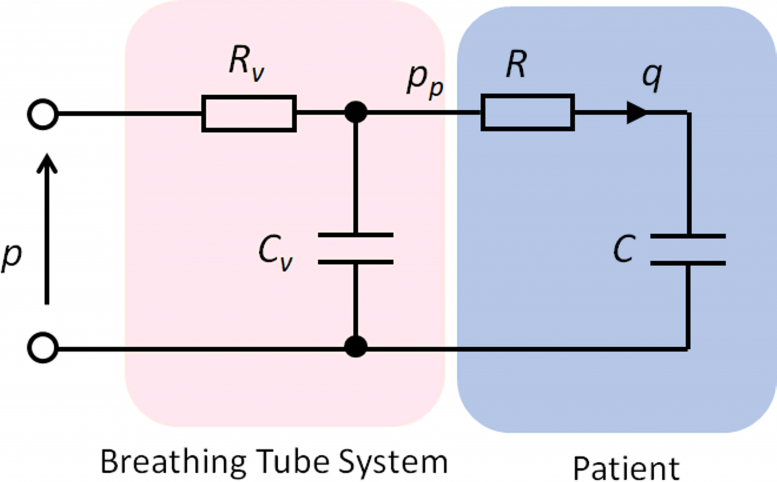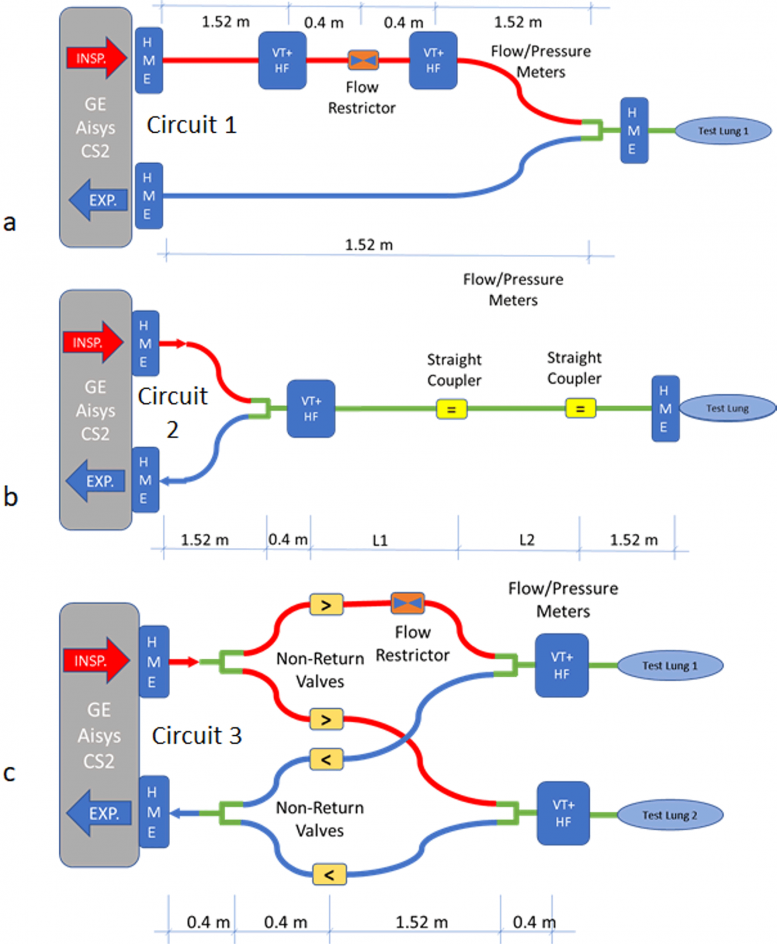
Simple RC network model of ventilator system and patient, with linear resistance (Rv) and compliance (Cv) for the ventilator tubing system, and linear resistance (R) and compliance (C) for the patient. Credit: University of Bath
Open-source model is shared to help medics around the world case of ventilator shortfalls.
As COVID-19 continues to put pressure on healthcare providers around the world, engineers at the University of Bath have published a mathematical model that could help clinicians to safely allow two people to share a single ventilator.
Members of Bath’s Centre for Therapeutic Innovation and Centre for Power Transmission and Motion Control have published a first-of-its-kind research paper on dual-patient ventilation (DPV), following work that began during the first wave of the virus in March 2020.
Professor Richie Gill, Co-Vice Chair of the Centre for Therapeutic Innovation and the project’s principal investigator, says: “We are not advocating dual-patient ventilation, but in extreme situations in parts of the world, it may be the only option available as a last resort. The COVID-19 crisis presents a potential risk of hospitals running short of ventilators, so it is important we explore contingencies, such as how to maximize capacity.”
Dual-patient ventilation presents several challenges: accurate identification of patients’ lung characteristics over time; close matching of patients suitable to be ventilated together, and the risk of lung damage if airflow is not safely maintained. The BathRC model enables doctors to calculate the amount of restriction required to safely ventilate two patients using one ventilator.
As a practice, DPV is strongly advised against by healthcare bodies given the potential for lung damage, and the team stresses that their findings should only be used in extreme situations where patients outnumber available equipment.
Prof Gill adds: “This isn’t something we’d envisage being needed for critical-care patients. However, one of the issues with COVID is that people can need ventilation for several weeks. If you could ventilate two recovering patients with one machine it could free up another for someone in critical need.”

HME = heat and moisture exchanger, VT+ HF = Fluke VT+ HF flow meter, INSP. = inspiration, EXP. = expiration. Credit: University of Bath
Accurate matching and correct resistance are key
No testing has been carried out on patients, instead, the research so far has taken place using artificial lungs, normally used to calibrate ventilators.
The model equates the ventilator circuit to an electrical circuit with resistance and compliance considered equivalent to electrical resistance and capacitance; this enabled a simple calculator to be created.
Prof Gill adds: “The BathRC model directly allows the restriction needed for safely ventilating two dissimilar patients using one ventilator.
“To reduce the risk of damage to a patient’s lungs, you need to ensure the correct flow of gases around the circuit by adding resistance. The simplest and most successful method we tried was modeled on an electrical circuit, hence the BathRC model name — where RC stands for resistance-compliance.”
While dual-patient ventilation has been previously attempted during the COVID-19 pandemic, the paper is the first to provide clinicians with the calculations needed to safely ventilate two patients with one machine. The model is able to predict tidal lung volumes accurately to within 4%.
In addition to further testing, some hurdles remain before clinicians could safely attempt dual-patient ventilation using the BathRC model. The team plans to publish further research soon into how to create an adjustable airflow restrictor.
The paper, A simple method to estimate flow restriction for dual ventilation of dissimilar patients: The BathRC model, is published in Plos One.
Reference: “A simple method to estimate flow restriction for dual ventilation of dissimilar patients: The BathRC model” by Andrew R. Plummer, Jonathan L. du Bois, Joseph M. Flynn, Jens Roesner, Siu Man Lee, Patrick Magee, Malcolm Thornton, Andrew Padkin, Harinderjit S. Gill, November 16, 2020, Plos One.
DOI: 10.1371/journal.pone.0242123
The University of Bath has several decades of world-leading expertise in the analysis and design of fluid systems, including modelling of ventilators.









Be the first to comment on "Open-Source Model Created to Help Clinicians Safely Ventilate Two COVID-19 Patients With a Single Ventilator"